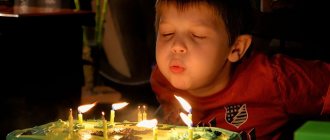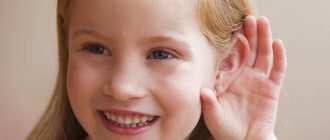Breathing is the energetic basis of spoken speech. The development of speech breathing largely determines the child’s formation of coherent speech, namely correct sound pronunciation, the ability to maintain normal speech volume, its smoothness and intonation expressiveness. By paying attention to establishing the correct speech breathing of the baby in early childhood, you can avoid many speech disorders in the future. In this article we will tell you about the features of speech breathing and ways of its development in preschool children.
Features of speech breathing in preschoolers
Speech breathing in preschool children differs from the breathing of adults and has its own characteristics:
- Insufficient development of the respiratory apparatus. If the inhalation and exhalation are weak, then the child’s speech will sound quiet and unintelligible. Sometimes, due to lack of air, children do not finish sentences. There are times when the baby tries to pronounce the entire phrase while inhaling, so he speaks quickly and does not observe logical pauses. Poor development of the respiratory system may be associated with the presence of chronic respiratory diseases in the child, such as sinusitis and sinusitis, as well as a sedentary lifestyle.
- Irrational distribution of exhaled air. Children who have recently learned to speak often run out of air on the first syllable, so they pronounce the end of a word or phrase much more quietly or even “swallow” it.
- Inability to distribute breathing according to words. To replenish the smell of the air, the child has to take a break, during which he may forget what he wanted to say.
- Speech sounds may be distorted due to improperly exhaled air.
Speech breathing in most preschool children is imperfect. But it is often difficult for parents to notice this due to the fact that they communicate with the baby constantly.
There are approximate norms for the number of words pronounced on exhalation, which can be used as a guide when assessing a baby’s speech breathing:
| Child's age | Number of words per exhale |
| 2-3 years | 2-3 words |
| 3-4 years | 3-5 words |
| 4-6 years | 4-6 words |
| 6-7 years | 5-7 words |
Breathing exercises. Reminder for COVID-19 patients
Completing the complex will allow you to support the respiratory system of the body, helping to restore the function of external respiration.
In addition, the healing and trophic effect of physical exercise has a stimulating effect on the entire body as a whole. Such exercises help improve gas exchange (in a gentle manner), strengthen the muscles involved in the act of breathing, increase the mobility of the diaphragm and chest, and also increase adaptation to physical activity.
Exercises, starting positions and features of their implementation, dosage and pace of execution will depend on the recovery period and the degree of your preparedness. For this purpose, various conditions and recommendations are proposed in the complex.
When starting to practice, you must remember and follow the following rules:
- You should start doing exercises only after the acute condition has stopped; in a positive mood.
- During the exercises, you should not feel a state of “lack of air,” sharp and strong heartbeat, or dizziness.
- The complex should be performed in a well-ventilated area.
- 40-60 minutes after eating!!! Cannot be performed on an empty stomach.
- The starting position can be any: sitting, standing, lying down.
- Regardless of the period, the pace of the exercises is slow, medium.
- In all exercises, a superficial (shallow) inhalation is performed through the nose, and exhalation through the mouth.
- The pulse (heart rate) should not increase by more than 10 beats/min.
- Do not include balloon inflation in your activities.
I period. Until all acute symptoms of dysfunction of external respiration (lack of air, feeling of compression of the chest, attacks of “uncontrollable coughing”) are relieved, the starting position is ONLY lying on your stomach;
II period. After the disappearance of acute symptoms (the first period) and then daily, provided that breathing function and well-being are restored, perform the exercises ONLY in a sitting position with your back tightly pressed to the back of the chair and a tense abdominal wall (stomach retracted);
III period. If there is no deterioration in well-being after exercise, and the pulse rate and breathing are uniform, it is possible to use the initial position lying on your back, standing with support, standing and walking.
| Guidelines | Exercises | Dosage | |
| I period. I.p. - lying on your stomach, head to the side, resting on your cheek or straight, arms along your body, legs apart. | |||
| Actively strain and pull your stomach with your diaphragm inward and upward. | Slowly inhale for 2 counts, exhale for 4 counts. | 4-6-8 times, rest interval between repetitions 30 seconds - 1 minute. | |
| Actively strain and pull your stomach with your diaphragm inward and upward. | Slowly inhale for 2 counts, exhale for 4 counts - bend slightly in the thoracic region (round back), hold for 2 counts. Slowly inhaling (shallowly) return to SP and relax. | 5-7 times, rest interval between repetitions 30 seconds - 1 minute. | |
| Actively strain and pull your stomach with your diaphragm inward and upward. | Slowly inhale for 2 counts, exhale for 4 counts - bend slightly in the thoracic region (round back), leaning on your palms - hold for 2 counts. Slowly inhaling (shallowly) return to SP and relax. | 4-6 times, rest interval between repetitions 30 seconds - 1 minute. | |
| II period. I.p. - sitting on a chair. | |||
| Sitting on a chair (like on a horse), clasping your arms and pressing your chest to the back of the chair. The abdomen is tense, the diaphragm is pulled inward - upward CONSTANTLY! | Slowly inhale incompletely for 4 counts, while simultaneously pressing your chest against the back of the chair, helping yourself with your hands, and relax as you exhale. | 6-8 times, rest interval between repetitions 30 seconds | |
| Sitting with your back resting on the back of a chair. The stomach is pulled in, hands are on hips, legs are relaxed. Breathing is free, unforced. | Slouching forward - slow, incomplete inhalation for 4 counts, straightening your back, bending over - exhale for 4 counts. Relax. | 4-6 times, rest interval between repetitions is 30 seconds, or as you feel. | |
| Sitting with your back resting on the back of a chair, your stomach is pulled in, your arms are hanging freely, your legs are relaxed. Breathing is free, unforced. | Inhale for 4 counts, while simultaneously clasping yourself with your arms crossed over your chest, relax your grip and exhale calmly. | 4-6 times, rest interval between repetitions is 30 seconds, or as you feel. | |
| Sitting with your back resting on the back of a chair, your stomach is pulled in, your arms are crossed around your chest in the diaphragm area, your legs are relaxed. Breathing is free, unforced. | Extend your right arm to the side 1-2 times - back, grab yourself by the chest with your left - inhale. Return to i.p. - exhale freely. Repeat the same with your left hand to the left. | 4-6 times, rest interval between repetitions is 30 seconds, or as you feel. | |
| Sitting with your back resting on the back of a chair. The stomach is pulled in, the arms are bent and pressed to the chest, the forearms are parallel, the hands are in a fist under the chin, the legs are relaxed. Breathing is free, unforced. | Perform for 1 count - jerky exhalation through the mouth, pulling the diaphragm inward - upward, straining the stomach and pressing the arms to the chest. Relax, breathe freely and shallowly. | 6-8 times, rest interval between repetitions 30 seconds, or as you feel | |
| Sitting on a chair. Hold the seat with your hands. | Perform bending for 2 counts, bringing the shoulder blades together - inhale shallowly, bend your torso forward, slightly rounding your back, exhale. | 4-6 times, rest interval between repetitions 30 seconds, or as you feel | |
| III period. I.p. – lying on your back; kneeling with emphasis on hands; standing with support; standing; while walking | |||
| Lying on your back, arms along your body. | Take a light, normal breath in 2 counts, close your lips and slowly exhale as if you were blowing out a candle. The stomach should retract as much as possible. | 4-6 times, do not force breathing - do not make you dizzy | |
| Lying on your back, arms at your sides. | On the count of 1.2, spread your arms to the sides - inhale, “hug yourself by the shoulders” - exhale on 5,6,7,8. | 6-8 times, rest interval between repetitions is 10-15 seconds, or as you feel. | |
| Lying on your back, arms along your body. Breathing is free. | Perform simultaneous clenching of the “hand into a fist” and flexion - extension in the ankle joints. | 10-12 reps | |
| Lying on your back, arms along the body, hands “locked.” | At 1.2 - simultaneously raise your arms up - inhale, at 3.4 return to the I.P. - exhale. | 6-8 times | |
| Lying on your back, arms along your body, legs bent. | Spread your arms to the sides - inhale 1.2, pull your knees to your chest, clasping your arms - exhale 3.4. Return to IP, relax. | 4-6 times, rest interval between repetitions is 30 seconds, or as you feel. | |
| Kneeling with emphasis on hands | Breathe with your stomach, protruding it as you inhale and relaxing it (pulling in your stomach) as you exhale. Breathing is free, without tension. | 3-6 reps | |
| Walking in place | Perform steps combined with breathing. At steps 1-4, smooth continuous inhalation, at steps 5-8, smooth slow exhalation. | Within 1-1.5 minutes | |
| Walking in place | Take a shallow breath for 1-2 steps; 3-4 step hold your breath while inhaling; Step 5-6 – exhale; Step 7-8 hold your breath while exhaling. | Within 1-1.5 minutes | |
Metered walking : start at a slow pace with 30-40 steps per minute, at a gradually increasing pace (not during one lesson!!!) - 60-80-100 steps per minute. Be sure to monitor your heart rate (count your pulse) at least 3 times: at the beginning, in the middle and at the end of the lesson. The pulse after exercise should return to its original values.
How to breathe correctly?
When diagnosing speech development, speech therapists always pay attention to how the child breathes during a conversation, the strength and duration of his inhalations and exhalations, and how he places pauses. Formation of speech breathing is one of the first stages of correctional work with a child who has any speech disorders. Correct speech breathing has the following signs:
- Short breath through the nose;
- Exhale smoothly, the air comes out through the mouth;
- Exhalation is carried out to the end;
- After each exhalation there should be a short pause (2-3 seconds).
The development of speech breathing is closely related to the functioning of physiological breathing.
| Physiological respiration | Speech breathing |
| Involuntary | free |
| Inhale - exhale - pause | Inhale - pause - exhale |
| Inhalation and exhalation are carried out in one impulse. | Inhalation is carried out with one impulse, exhalation - with several (depending on the content of the statement). |
Only by learning to breathe correctly (deep short inhalation and smooth long exhalation) will a child be able to fully master his voice. The most effective methods of working with preschoolers are breathing exercises. Conventionally, they can be divided into two large groups, depending on their purpose:
- Formation of correct exhalation;
- Breathing training using various speech materials (practicing the pronunciation of sounds and their combinations, learning poetry).
The development of speech breathing in preschoolers allows:
- Speed up the process of staging and automating speech sounds;
- Increase the number of words that the baby pronounces in one exhalation;
- Form intelligible, coherent speech;
- Coordinate the processes of speech, breathing and movements.
Exercises to train the muscles of the tongue and normalize the type of swallowing
Exercise No. 1 “Clock”. The mouth is open, the tongue makes slow circular movements along the upper lip, then along the lower lip.
Exercise No. 2 “Punish the naughty tongue.” Place your tongue on your lower lip and slap it with your upper lip “na-na.”
Exercise No. 3 “We will paint the ceiling.” It's time to paint the rooms, they invited a molar, he comes to the old house with a new brush and bucket. Your tongues are a brush, your hard palate is the ceiling...
Exercise No. 4 Depict the operation of a jackhammer. DDDD...
Exercise No. 5 “Riders”. Sit astride the toilet seat and, opening your mouth wide, click your tongue.
Exercise No. 6 Lift the tongue up, press it to the front part of the hard palate in the area of the palatine folds. Clench your teeth, swallow saliva, fixing the position of your tongue.
Exercise No. 7 Raise the tip of the tongue up and place it at the anterior part of the hard palate. Move the tongue along the arch of the hard palate as far back as possible to the soft palate.
Exercise No. 8 Raise the tip of the tongue up and place it at the anterior part of the hard palate. Move your tongue along the palatal surface of the teeth on the right and left, touching each tooth.
Recommendations for performing breathing exercises
- Classes must be carried out in a well-ventilated area;
- All exercises should be performed before meals;
- Clothing should not hinder the baby's movements;
- The muscles of the child’s neck, shoulders, arms, chest and abdomen should be relaxed;
- Inhalation should occur through the nose;
- The exhalation should be long and smooth;
- Make sure that when performing breathing exercises, the child does not puff out his cheeks. At first, you can hold them with your palms;
- 3-5 repetitions of each exercise are enough, between which you should take a 2-3 second pause. The total duration of breathing exercises should not exceed 5 minutes.
It is very important to measure the amount of breathing exercises and perform them at a moderate pace to avoid hyperventilation.
Additional special exercises
Exercise No. 1. Slowly push the lower jaw forward until the cutting edges of the lower incisors are positioned in front of the upper ones. Hold the lower jaw in this position for 10 seconds, then slowly return to its original position.
Exercise No. 2. Perform the same exercise with a spank of the head, first to the right, then to the left. The load increases when performing the exercise while standing. The head is slightly tilted back, the lower jaw is slowly pushed forward until the lower incisors are positioned in front of the upper ones.
Exercise No. 3 (with the vestibular plate). The vestibular plate is placed in the vestibule of the oral cavity, with 1 finger of the right hand it is pulled forward by the ring and held with pursed lips.
Exercise No. 4. Place a folded strip of paper between your lips and purse your lips. The paper is held for up to 30-50 minutes during quiet games, drawing, reading, or when the child is watching TV.
Exercise No. 5. Perform the previous exercise, replace the strip of paper with a metal disk with a diameter of 2.5-3 cm, a thickness of 1.5 mm and a mass of about 6.5 g. The disk clamped between the lips should be positioned horizontally, it is necessary to ensure that the disk is only clamped lips, not teeth. The exercise is performed until fatigue (from 30 seconds to several minutes).
Exercise No. 6 (with a plastic plate). The child presses the edge of the plate, 1-2 mm thick and 30-35 mm wide, with his lips. 60-120 mm long. and holds it in a horizontal position. Some kind of weight is placed on the plate. Increasing the load causes increased clenching of the lips.
Exercise No. 7. Small cotton rolls are placed in the area of the transitional fold of the vestibule of the oral cavity on both sides of the frenulum of the upper lip. Close your lips and pronounce a series of phrases containing labial sounds (“b”, “m”, “p”).
Exercises to develop the strength and duration of exhalation
- Breeze. Tie several ribbons of serpentine or Christmas tree rain to a thread or lace. Invite your baby to blow on them and create a breeze. You can make the task more difficult by asking them to blow on ribbons of a certain color. The distance between the face and the ribbons should be approximately 10-15 cm.
- Leaf fall. Cut out real autumn leaves from paper or collect them from the street. Together with your child, you can arrange a real leaf fall by blowing them off the table. In the winter season, you can also play with paper snowflakes.
- Fly, feather! Let the baby throw the feather up and blow on it from bottom to top, not letting it fall.
- Pencil athletes. Draw start and finish lines on the table. At the start, put two pencils of different colors. Take turns blowing with your child on his own pencil and arrange a competition to see which of them will “run” to the finish line first.
- Sailors. Make boats out of paper or cork and lower them into a basin of water. There is a strong wind at sea - we blow on the ships, forcing them to move.
- Blow out the candles. You can role-play a birthday situation with your child. Prepare a toy set, cake and real candles. By blowing out the candles, you can make a wish.
- Pinwheel. A fidget toy is great for creating proper exhalation. Children love to watch the rotating blades and are proud of the result of their efforts.
- Whistles with the sounds of various animals and birds will also delight the baby and will be very useful for the development of his speech breathing.
- Another simple way to practice breathing is using soap bubbles.
Make sure that the child makes smooth and long exhalations. Gradually make the exercises more difficult by increasing the distance between your face and the object being deflated.
Exercises to practice correct pronunciation of sounds and syllables
To teach your baby to correctly pronounce vowels and consonants, syllables and sound combinations, you need to train them to pronounce them in one exhalation. Invite your baby to sing “songs” that imitate various sounds:
- “Ahhh!” - the baby is crying;
- "Uh-oh!" - the plane is flying;
- “Y-y-y!” — the steamer is humming;
- “Oh-oh-oh,” the bunny sighs;
- “F-f-f” - the balloon deflates;
- “Sh-sh-sh” - the snake hisses;
- “Ssss” - the pump is running;
- “Beep!” - the car honks;
- “Too-too” - the locomotive is moving;
- “La-la-la” - the doll sings;
- “Top-top-top” - the bear goes;
- “Drip-drip-drip” - it’s raining.
To engage your child, create a playful situation using your child’s favorite toys in class. Reinforce your speech with appropriate actions, and let the baby repeat after you.









